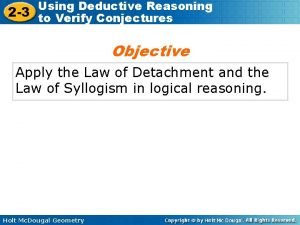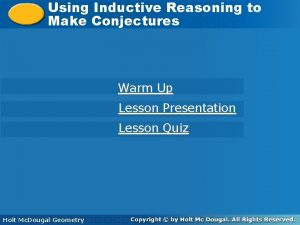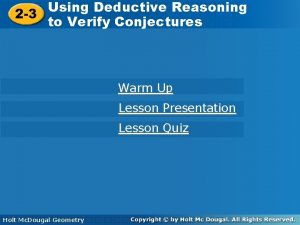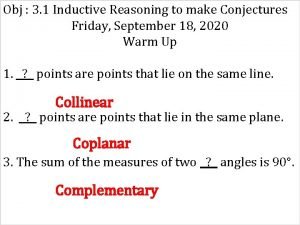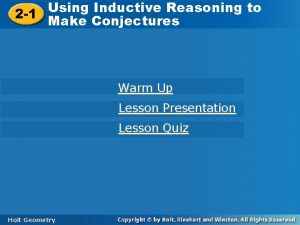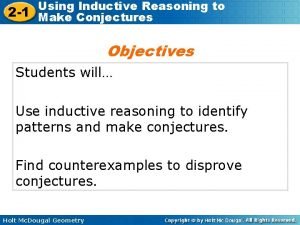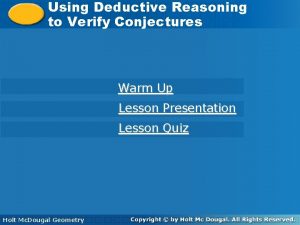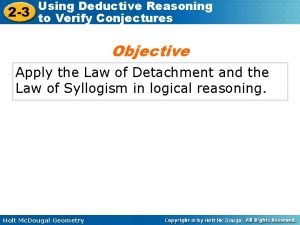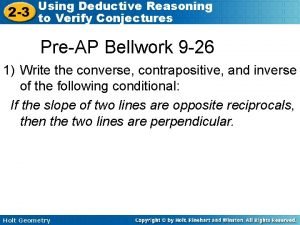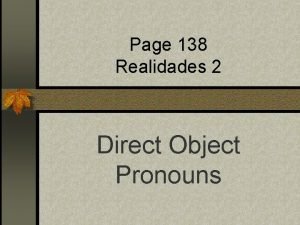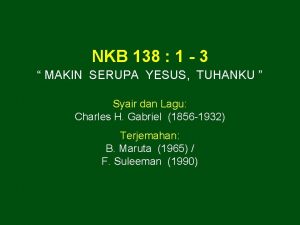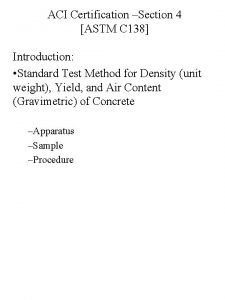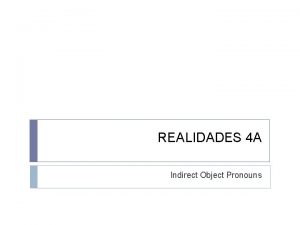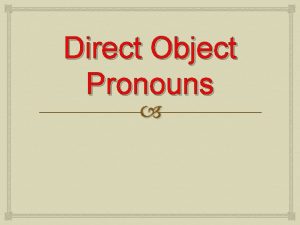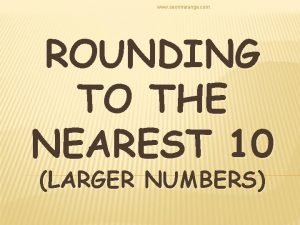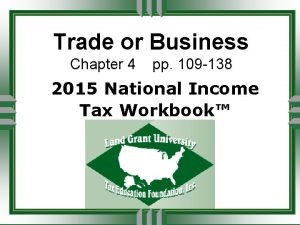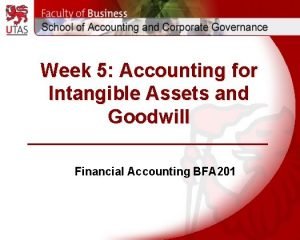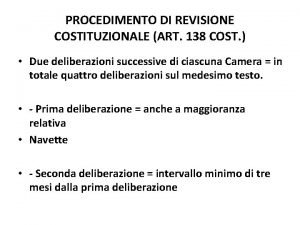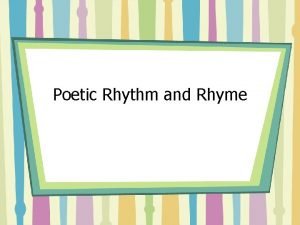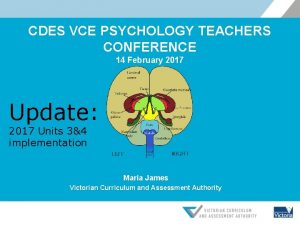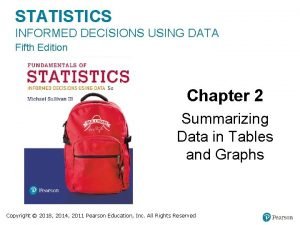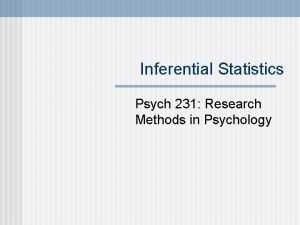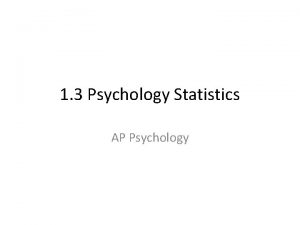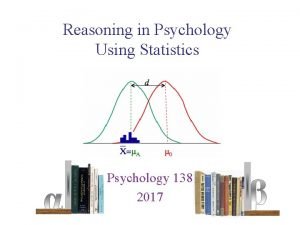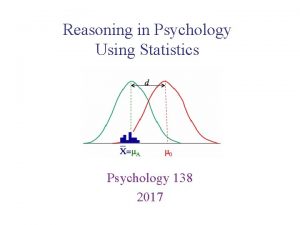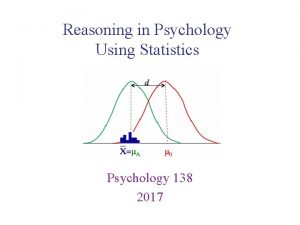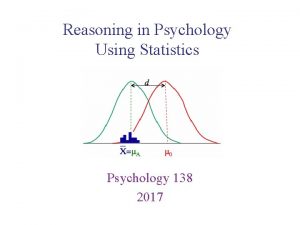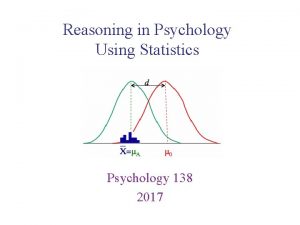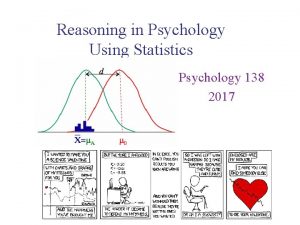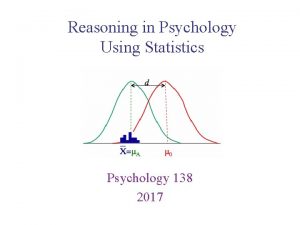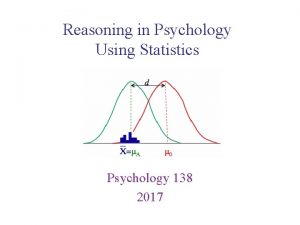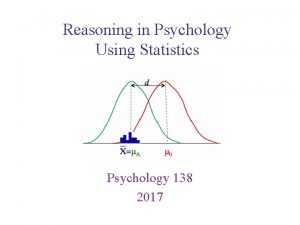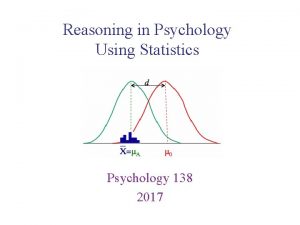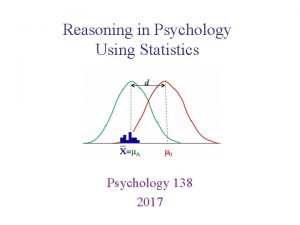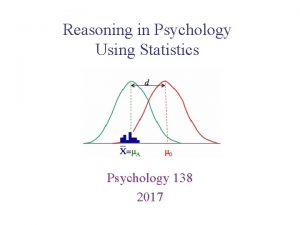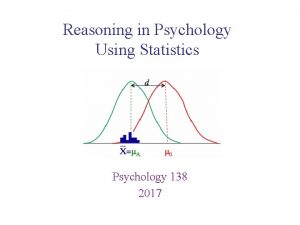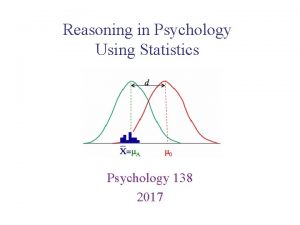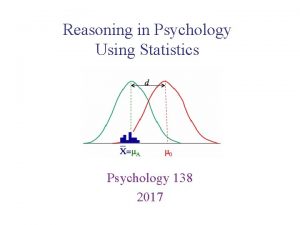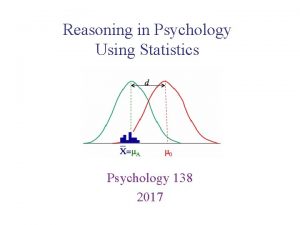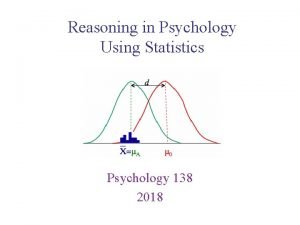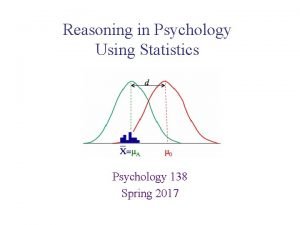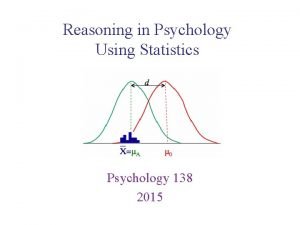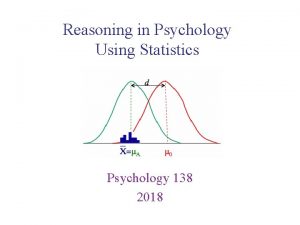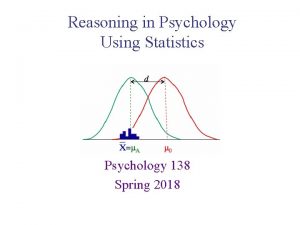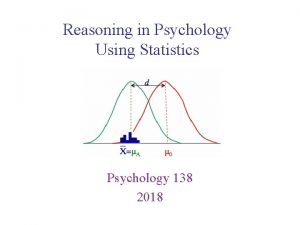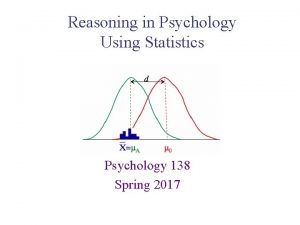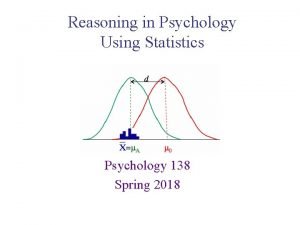Reasoning in Psychology Using Statistics Psychology 138 2017













































- Slides: 45

Reasoning in Psychology Using Statistics Psychology 138 2017

• Summaries or pictures of the distribution • Numeric descriptive statistics – Shape: modality, and skew (and kurtosis, not cover much) – Measures of Center: Mode, Median, Mean – Measures of Variability (Spread): Range, Inter-Quartile Range, Standard Deviation (& variance) Reasoning in Psychology Using Statistics Descriptive statistics

• Useful to summarize or describe distribution with single numerical value. – Value most representative of the entire distribution, that is, of all of the individuals – Central Tendency: 3 main measures – Mean (M) – Median (Mdn) – Mode • Note: “Average” may refer to each of these three measures, but it usually refers to Mean. Reasoning in Psychology Using Statistics Measures of Center

• Most commonly used measure of center • Arithmetic average – Computing the mean – Formula for population mean (a parameter): – Formula for sample mean (a statistic): –Note: Mean is mathematical result, not necessarily score on scale (e. g. , average of 2. 5 children) Reasoning in Psychology Using Statistics The Mean M= Divide by the total number in the population Add up all of the X’s Divide by the total number in the sample

– Conceptualizing the mean As the center of As the representative the distribution score in the distribution Reasoning in Psychology Using Statistics The Mean

– Conceptualizing the mean As center of As representative score distribution in distribution Reasoning in Psychology Using Statistics The Mean

– Conceptualizing the mean As center of As representative score distribution in distribution Reasoning in Psychology Using Statistics The Mean

– Conceptualizing the mean As center of As representative score distribution in distribution Reasoning in Psychology Using Statistics The Mean

– Conceptualizing the mean As center of As representative score distribution in distribution Balancing point Reasoning in Psychology Using Statistics The Mean

– Conceptualizing the mean As center of As representative score distribution in distribution 1 2 3 4 5 6 7 8 9 10 1+10 = 11 Mean = 11/2 = 5. 5 Reasoning in Psychology Using Statistics Balancing point The Mean

– Conceptualizing the mean As center of As representative score distribution in distribution 1 2 3 4 5 6 7 8 9 10 Balancing points Reasoning in Psychology Using Statistics The Mean

– Conceptualizing the mean As center of As representative score distribution in distribution 1 2 3 4 5 6 7 8 9 10 Reasoning in Psychology Using Statistics The Mean What happens if we add an observation to our distribution?

– Conceptualizing the mean As center of As representative score distribution in distribution 1 2 3 4 5 6 7 8 9 10 Reasoning in Psychology Using Statistics The Mean What happens if we add an observation to our distribution?

– Conceptualizing the mean As center of As representative score distribution in distribution 1 2 3 4 5 6 7 8 9 10 Reasoning in Psychology Using Statistics The Mean What happens if we add an observation to our distribution?

– Conceptualizing the mean As center of As representative score distribution in distribution 1 2 3 4 5 6 7 8 9 10 Reasoning in Psychology Using Statistics The Mean What happens if we add an observation to our distribution?

– Conceptualizing the mean As center of As representative score distribution in distribution 1 2 3 4 5 6 7 8 9 10 1+10+7 = 18 Mean = 18/3 = 5. 5 Reasoning in Psychology Using Statistics What happens if we add an Balancing observation to our distribution? point The Mean

– Conceptualizing the mean As center of As representative score distribution in distribution 1 2 3 4 5 6 7 8 9 10 1+10+7 = 18 Mean = 18/3 = 6. 0 Reasoning in Psychology Using Statistics The Mean What happens if we add an observation to our distribution?

– Conceptualizing the mean As center of As representative score distribution in distribution 1 2 3 4 5 6 7 8 9 10 1+10+7 = 18 Mean = 18/3 = 6. 0 Reasoning in Psychology Using Statistics The Mean What happens if we add an observation to our distribution?

– Conceptualizing the mean As center of As representative score distribution in distribution 1 2 3 4 5 6 7 8 9 10 1+10+7 = 18 Mean = 18/3 = 6. 0 Reasoning in Psychology Using Statistics The Mean What happens if we add an observation to our distribution?

– Conceptualizing the mean As center of As representative score distribution in distribution 1 2 3 4 5 6 7 8 9 10 1+10+7 = 18 Mean = 18/3 = 6. 0 Reasoning in Psychology Using Statistics What happens if we add an observation to our New Balancing distribution? point The Mean

– Conceptualizing the mean As center of As the representative To be fair, let’s give distribution score in the distribution everybody the Girl Scout bake sale for camping trip same amount. 1 2 3 4 5 6 7 8 9 10 $12 $25 $30 $6 $18 $15 12+25+30+6+18+15+13=119 Reasoning in Psychology Using Statistics The Mean $13 119/7 = 17

– Conceptualizing the mean As center of As representative score distribution in distribution Girl Scout bake sale for camping trip 1 2 3 4 5 6 7 8 9 10 $17 $17 $17 12+25+30+6+18+15+13=119 $17 119/7 = 17 So everybody is represented by same score, the mean is the “standard” 17+17+17+17=119 119/7 = 17 Reasoning in Psychology Using Statistics The Mean

• Suppose that you combine 2 groups together. – How do you compute new group mean? Average the 2 averages But it only works this way when the two groups have exactly the same number of scores Reasoning in Psychology Using Statistics A weighted mean

• Suppose that you combine 2 groups together. – How do you compute new group mean? Group 1 Group 2 New Reasoning in Psychology Using Statistics A weighted mean $205!? I only have $191 Group

• Suppose that you combine 2 groups together. – How do you compute new group mean? Group 1 Group 2 New Group 12+25+30+6+18+15+13+25+17+30=191 Mean = 191/10 = 19. 1 $30 $12 $25 $6 $17 $30 $25 $18 $15 $12 $30 $17 $15 Reasoning in Psychology Using Statistics A weighted mean $13 $18 $13 $6 $30 $25

The mean thecombine 2 groups together. • Suppose that is you score in new group mean? –representative How do you compute the distribution Group 1 Group 2 New Group $17 $17 $24 $24 $17 Reasoning in Psychology Using Statistics $17 A weighted mean

• Change/add/delete a given score, then the mean will change. – Suppose that one of the girl scouts discovered that she had really made $23 instead of $30. So now the total is 119 -7=112 112/7 = $16 (instead of $17) 5 10 15 20 25 30 17 Reasoning in Psychology Using Statistics Characteristics of a mean

• Change/add/delete a given score, then the mean will change. – Suppose that one of the girl scouts discovered that she had really made $23 instead of $30. So now the total is 119 -7=112 112/7 = $16 (instead of $17) 25 30 0 2 5 1 0 1 5 17 Reasoning in Psychology Using Statistics Characteristics of a mean

• Change/add/delete a given score, then the mean will change. – Suppose that one of the girl scouts discovered that she had really made $23 instead of $30. So now the total is 119 -7=112 112/7 = $16 (instead of $17) 5 10 15 20 25 30 16 Reasoning in Psychology Using Statistics Characteristics of a mean

• Change/add/delete a given score, then the mean will change. • Add/subtract a constant to each score, then the mean will change by adding(subtracting) that constant. – Suppose that you want to factor out a $2 camping fee for each girl scout. Subtract 2 from each amount. Now the total is $105, so the mean is 105/7 = $15. – But notice you could have just subtracted $2 from the previous mean of $17 and arrived at the same answer. Reasoning in Psychology Using Statistics Characteristics of a mean

• Change/add/delete a given score, then the mean will change. – Suppose that the troop sponsor agreed to match the money made by each girl scout (they give each girl scout an additional amount • Add/subtract a constant to each score, then the of money equal to however much each made on the sale). So now mean willischange adding(subtracting) the total $238, andby the mean for each girl is 238/7 =that $34 – Which is 2 times the original mean constant. • Multiply (or divide) each score by a constant, then the mean will change by being multiplied by that constant. Reasoning in Psychology Using Statistics Characteristics of a mean

• Median divides distribution in half: 50% of individuals in distribution have scores at or below the median. – Case 1: Odd number of scores Step 1: put scores in order $12 Reasoning in Psychology Using Statistics $25 $30 $6 $18 $15 The median $13

• Median divides distribution in half: 50% of individuals in distribution have scores at or below the median. – Case 1: Odd number of scores Step 1: put scores in order Step 2: find middle score $6 $12 $13 $15 $18 $25 $30 That’s the median, a score on scale Reasoning in Psychology Using Statistics The median

• Median divides distribution in half: 50% of individuals in distribution have scores at or below the median. – Case 2: Even number of scores Step 1: put scores in order Step 2: find middle 2 scores $6 $12 $13 $15 $18 $25 $30 Step 3: find arithmetic average of 2 middle scores That’s the median Note: mathematical result not a score on scale Reasoning in Psychology Using Statistics The median

• Mode: score or category with greatest frequency. – Pick variable in frequency table or graph with highest frequency (mode always a score on scale). Mode = 5 Mode = Medium Reasoning in Psychology Using Statistics The mode Modes = 2, 8

• Depends on a number of factors, like scale of measurement and shape. – The mean is the most preferred measure and it is closely related to measures of variability – However, there are times when the mean is not the appropriate measure. Reasoning in Psychology Using Statistics Which center when?

• If data on nominal scale: Mode only – – Unranked categories (e. g. eye color) Not a numeric scale Can not do arithmetic operations on values Can not calculate cumulative percentages Eye color Mode = Brown Median = Green Reasoning in Psychology Using Statistics Which center when?

• If data on ordinal scale: Median (plus Mode) – Not a numeric scale (e. g. , T-shirt size) – Can not do arithmetic operations on values – Can calculate cumulative percentages on frequencies (median is score at 50 th percentile) Median of T-shirt size = Medium Mode of T-shirt size = Medium Reasoning in Psychology Using Statistics Which center when?

• If data on interval or ratio scale BUT: – Distributions open-ended • Response category like “ 5 or more” • Extreme values unknown, so can not calculate mean – Distributions skewed with long tails • Extreme values over influence mean • E. g. , income sample of 50 – 47 middle income ($60, 000 -$100, 000) and 3 millionaires or billionaires – Median = $80, 000 – Mean = $135, 000 or $60, 000 • Median (plus Mode) Reasoning in Psychology Using Statistics Which center when?

• If data on interval or ratio scale AND no exclusionary conditions: Mean (plus Median) (plus Mode) – Numeric scale – Can do arithmetic calculations on values – Have benefit of other statistics using the mean, such as standard deviation Reasoning in Psychology Using Statistics Which center when?

Situation Most Representative Nominal Mode Ordinal Median Mode Skewed interval or ratio Median Mode Open ended interval or ratio Median Mode Interval or Ratio Mean Mode Reasoning in Psychology Using Statistics In Summation Least Representative Can’t Use Median/Mean

• Impact of shape on center (interval or ratio scale) mean = median = mode Positively skewed distribution mean > median > mode mean = median, 2 modes Negatively skewed distribution mean < median < mode Mean & median pulled toward tail Reasoning in Psychology Using Statistics Which center when?

Mode Median Mean Reasoning in Psychology Using Statistics 0 -10, 000 45, 734 ? 175 -200, 000 261, 600 325, 212 Chicago distributions Check out your hometown: http: //www. city-data. com/

price of Mode The average 0 -10, 000 houses in this Medianneighborhood 45, 734 is … Mean ? buying 175 -200, 000 261, 600 325, 212 selling When you say “average” are you talking about the median or the mean? Reasoning in Psychology Using Statistics Buyer beware: Know your distribution

• Today’s lab – Compute mean, median, & mode both by hand & using SPSS • Questions? Reasoning in Psychology Using Statistics Wrap up
 Reasoning vs evidence
Reasoning vs evidence Deductive vs inductive
Deductive vs inductive Deductive reasoning
Deductive reasoning Examples of deductive reasoning
Examples of deductive reasoning Deductive vs inductive geometry
Deductive vs inductive geometry Patterns and inductive reasoning
Patterns and inductive reasoning Inductive method definition
Inductive method definition Introduction to statistics what is statistics
Introduction to statistics what is statistics Using deductive reasoning to verify conjectures
Using deductive reasoning to verify conjectures Using inductive reasoning to make conjectures answers
Using inductive reasoning to make conjectures answers 2-3 using deductive reasoning to verify conjectures
2-3 using deductive reasoning to verify conjectures Using inductive reasoning to make conjectures
Using inductive reasoning to make conjectures Inductive reasoning
Inductive reasoning Using inductive reasoning to make conjectures
Using inductive reasoning to make conjectures Using deductive reasoning to verify conjectures
Using deductive reasoning to verify conjectures Using deductive reasoning to verify conjectures
Using deductive reasoning to verify conjectures 2-3 using deductive reasoning to verify conjectures
2-3 using deductive reasoning to verify conjectures Salmo 138:5
Salmo 138:5 Direct object pronouns (p. 138)
Direct object pronouns (p. 138) Nkb 194
Nkb 194 Hpd 138 uitm
Hpd 138 uitm Direct object pronoun of la mochila
Direct object pronoun of la mochila Adjective with v
Adjective with v Aci c138
Aci c138 Psalm 138:1-3
Psalm 138:1-3 Tiempo de orar salmo 138
Tiempo de orar salmo 138 Tec-138-702
Tec-138-702 Pg 138
Pg 138 Capitulo 4a indirect object pronouns continued
Capitulo 4a indirect object pronouns continued Direct object pronouns (p. 138)
Direct object pronouns (p. 138) Round 2 617 to the nearest ten
Round 2 617 to the nearest ten 109+138
109+138 Ps 138
Ps 138 How to compute for impairment loss
How to compute for impairment loss 2 corinthians 4 nasb
2 corinthians 4 nasb Art 138 cost
Art 138 cost Iambic trochaic
Iambic trochaic Ilo 138
Ilo 138 Vcaa psychology exam 2017
Vcaa psychology exam 2017 Statistics informed decisions using data 5th edition pdf
Statistics informed decisions using data 5th edition pdf Statistics for managers using ms excel solutions
Statistics for managers using ms excel solutions Transductive reasoning psychology
Transductive reasoning psychology Inferential statistics in psychology
Inferential statistics in psychology Descriptive statistics ap psychology
Descriptive statistics ap psychology Standard deviation in psychology
Standard deviation in psychology Using system.collections.generic
Using system.collections.generic








